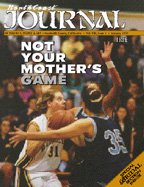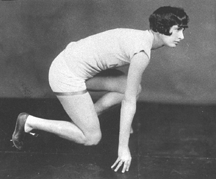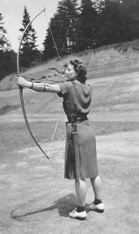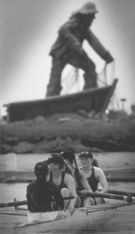


by Jim Hight
It was a Friday night in early December. With drums beating and onlookers screaming, 10 women focused their senses like animals on the hunt. In packs of five, they raced back and forth, passing a 20-ounce leather ball between them until one of their own could toss it through the air toward a wire hoop.
When they scored -- or stole the ball from an opponent -- they exalted. When they were scored upon or blocked, they raged inside for an instant before rejoining the hunt.
After 40 minutes of play and nearly two hours of breaks for penalties, strategy and rest, the Humboldt State University Lumberjacks had pierced the hoop more often than the Holy Name Hawks, and they retired to the showers spent and satisfied.
This game on Dec. 6 at the HSU East Gym was a relatively easy one for the Jacks, and many of their reserve players saw game time. Guards Deanna Viscuso, Palley Demeter and Maria Durazo all played and scored, as did reserve center Elizabeth Songer and backup forward Kristen Swain.
Starting center Sarah Trobee was the leading scorer with 14, followed by guard Teresa Farmer, who scored nine and stole the ball twice.
Sweaty and bruised after the game, Farmer tried to describe what it felt like on the court. "It's the thrill of competition," she said with a touch of shyness that was a sharp contrast to her aggressive game style. "It's a rush. You just have to have fun."
Reserve guard Maria Durazo "red-shirted" last year -- worked out with the team but didn't play. But after a summer of conditioning, the sophomore from Happy Camp is a full team member this year. "I got in weight training and now I am there defensively, I have much more power."
Durazo, Farmer and other members of the team seem so at ease with the intensity and joy of sports that it's hard to imagine a time when women were discouraged -- even prohibited -- from playing competitively.
At Humboldt State University in particular, where women's sports today are on a par with men's, it's hard to imagine an era when doctors preached that a woman would damage her reproductive system if she played basketball vigorously.
And in communities where high school girls compete all year long in any of seven different interscholastic sports, it's hard to imagine a time not too long ago when athletics for teenage girls was limited to giggly "play days."
But in the stands at the HSU-Holy Name game -- and at most every other college or high school or junior high school game in the county -- the mothers of today's young female athletes can well remember when the thrill of sports competition was out of their reach.
"We had a girls' athletic association, but it was just P.E. We didn't have any competition with other schools," said Pat Durazo, Maria's mother, who attended the HSU-Holy Name game.
"Maria is getting many more opportunities ... to be equal with men all the way. I think it gives her more self-confidence and makes her more decisive and stronger."
But coming this far has been a long, hard struggle. And some women in sports say that gender equity -- mandated by federal law since 1972 -- is still a goal rather than a reality in many schools.
"Some administrators and campuses have been very hostile to women moving forward in athletics," said Elizabeth Toledo, president of California National Organization for Women.
And the anti-affirmative action Proposition 209, which passed in November, may undermine the future of women's sports by slowing the training and hiring of female coaches.
But by most standards, girl and women athletes today have broken free of the rigid limitations that kept women out of competitive sports.
Through most of the 20th century, while men's sports were taking great strides, female athletics were handicapped by the widespread belief that women were not fit to compete.
"There was a belief that women could participate in sports but not too vigorously," said Al Figone, an HSU professor who teaches the sociology of sports. "Competitive athletics was deemed not good for women."
With some regional exceptions, this philosophy held sway, especially regarding basketball. For females, the court was divided up into zones, and special rules limited how much they could run. "Physicians were totally opposed to women playing full-court basketball. They believed it would destroy a woman's internal organs," said Figone.
Women competitors also would have challenged the definition of what a woman could do in other areas of society, such as business and government. "There was an ideology prevalent that said, 'If women take part in sport, it's bad for society,'" Figone said.
Some women competed in individual sports such as swimming and track and field. In fact, Eureka High School had a strong girls' athletics program under Laura Herron in the 1920s. Herron joined the HSU faculty in 1926, and one of her track stars, Elta Cartwright of Eureka, went on to win the 100-meter race in the national Olympic Trials.

Elta Cartwright travelled to Amsterdam to compete in the 1928 Olympics. Photo courtesy AAUW)
Cartwright entered the 1928 Olympics in Amsterdam but performed poorly due to the effects of seasickness from her long voyage. (Elta Cartwright Henricksen, 89, lives in Ferndale and was honored last year by the Humboldt County chapter of American Association of University Women.)
But in college team sports, there was a prohibition against interscholastic competition for women. Women played the games, but only in intramurals, within the school.
Long-time Arcata resident Monica Hadley remembers being shocked to learn that the aggressive competition she had enjoyed as a high school basketball player in rural Idaho was decidedly unwelcome at the University of Washington, where she went to study physical education.

Arcatan Monica Hadley remembers physical edication classes for women being well-rounded but rarely competitive. Photo courtesy of Monica Hadley)
"I liked sports and I was really a good basketball player," Hadley said. "When I went to the University of Washington, there was an entirely different philosophy they didn't think girls, as they called them then, should be in the hard competition, that it was not good for them physically or mentally.
"It was an adjustment to make because I didn't think it had ever hurt me," she said.
After completing her master's in physical education, Hadley took a job as assistant professor at Humboldt State University in 1933. She remembers hoping that interscholastic competition for women might have been acceptable at HSU, but when she got there she was disappointed.
The new head of the women's P.E. department had graduated from Mills College, where the "no-competition" philosophy was strong. "We talked about it and it was quite an issue between us," Hadley said. "She just thought it was absolutely wrong."
Even when the owner of the Eureka Standard newspaper suggested a promotional game between male and female basketball players, the department head would not allow it, Hadley recalled.
She said that her own convictions about women's abilities to compete began to diminish in the face of the dominant beliefs about female frailties. "I was beginning to feel there could be something to it." So even after her boss moved on and she became head of the women's P.E. department, she didn't attempt to change the status quo.
World War II brought millions of American women into the industrial work force and with major league baseball players in the armed forces, the war set the stage for the creation of a women's baseball league, as shown in the film "A League of Their Own."
But after the war, the women's baseball league was disbanded, although a tradition of amateur women's softball did endure after the postwar years, accounting in part for the continuing popularity of women's softball today.
Through the 1950s and into the 1960s, women's competitive sports remained minimal. HSU's women's basketball players played other schools once a year in an informal tournament in Santa Rosa, according to a history provided by the Sports Information office.
Then came the civil rights and women's liberation movements of the late 1960s and early 1970s. The vastly unequal public funding for women's sports in high schools and colleges became a target, and things began to change, but with aching slowness for female athletes who craved the higher levels of coaching and competition that male athletes experienced.
"There were no organized teams for girls through my junior high, that was seventh through ninth grades," said Pam Martin, head women's basketball coach at HSU. "It wasn't until 10th grade that I started playing organized basketball (and other sports). We had a league and there was competition, but (unlike boys' teams) there was no post-season play."
Martin graduated from high school in 1974, two years after passage of the landmark federal law that was supposed to change all that: Title IX of the Education Amendment of 1972, a legislative product of the civil rights and women's movements.
Title IX said, "No person in the United States shall, on the basis of sex, be excluded from participation in, be denied the benefits of or be subjected to discrimination under any educational program or activity receiving federal financial assistance."
The gender equity requirements in Title IX -- as well as the growing desire of young women to compete -- pushed schools to make some changes. Martin and her assistant coach, Carol Harrison, mark 1974 as a watershed year: The University of California, Los Angeles gave the first known scholarship to a female basketball player, Ann Meyers (widow of the late Don Drysdale, and now a commentator for sports telecasts).
Recruiting for women's basketball picked up in the 1980s, according to Martin and Harrison, who spend several weekends a year visiting high school basketball players to pitch them on HSU's academic and sports programs. (HSU, like the other colleges in the Northern California Athletic Conference, offers no scholarships.)

Photo by Keith Scheffield
But true gender equity still lagged at HSU and across the state system of higher education until the California chapter of National Organization for Women filed a lawsuit against the state universities in 1993.
At that time only 30 percent of the opportunities for interscholastic competition at the California State University system were open to women, according to NOW, while more than 50 percent of the students were female.
The suit was settled in 1993 with a consent decree under which the CSU agreed to increase women's sports opportunities to a level within 5 percent of a school's male-female population ratio by 1999. In other words, if 50 percent of a college's students are women, at least 45 percent of the interscholastic athletic slots have to be for women.
At HSU that meant the addition of women's soccer and crew teams to help balance men's sports enrollment, football in particular, which involves up to 80 men per year. (Both soccer and crew had been "club" sports before, funded entirely by participants; now they're funded by the university.) "HSU was the first (state university) to come into compliance," said Sports Information Director Dan Pambianco.
The university managed to accomplish this without taking the bitter pill that other state colleges -- including San Francisco, Hayward and, just last month, Sonoma -- chose to swallow: eliminating football.
While College of the Redwoods was not directly affected by the NOW lawsuit, the institution recently graded itself on gender equity in sports.
It flunked.
At a school with more than 50 percent female students, there were 106 male athletes and 34 female athletes last year. Male coaches are all full-time, females part-time. About $4,600 was spent for men's sports coaching assistants, nothing for women's assistants.
In response, the college developed a plan to improve gender equity. It included: adding women's softball by 1997 and soccer by 1999; increasing female athletic participation to 45 percent by 2000; and hiring at least one more full-time coach for women's sports.
Athletic Director Tom Giacomini acknowledged that the inequality in numbers is largely due to football. "With 55 participants, it's hard to find a sport for women that can equal that." But he and other college administrators said the college is giving no consideration to eliminating that sport. "It's a big unifying thing for the community and there's a high demand for it among students," Vice President of Academic Affairs Al Kurki said.
Giacomini also said that female students' lack of interest in competitive sports is also responsible for the smaller women's program. "In the past our turnouts for softball barely kept that program alive." But he believes that soccer in particular will become a more popular program at CR, given its growing popularity in high schools.
The issue of whether CR's next women's sports coach will be a woman is a difficult one.
When schools began to make sports more equal by gender, one of the steps they took was to hire and place more men as coaches of female sports. "Title IX does not say that females should be coaching females," said Marla Gleave, women's basketball coach at CR. "It says that female sports participants should have just as qualified a coach as male participants."
And until recently, the most qualified coach was usually a man.
"Women were not in a position to get those jobs because they didn't have the experience," said Martin of HSU. "It's been a slow change to the point where now you see more and more women who've played Division 1 ball getting graduate assistantships while they earn their master's degrees, and from there moving in as assistant in some program. None of those things were available (to women) in the '70s and '80s."
With women athletes and coaches still playing catch-up in the game of academic hiring and promotions, "affirmative action is still needed to increase the numbers of full-time female coaches," believes CR's Gleave.
But Proposition 209, if it survives legal challenges, may make it more difficult for CR to hire a woman. While the college expects many qualified female applicants, "if they are seeking a particular gender to fill a particular job, that could easily be interpreted by the courts as a violation of (209's) anti-preference mandate," said Elizabeth Toledo of NOW.
On the other hand, 209 does allow employers to seek a person of one gender for a position if it is "reasonably necessary."
For North Coast players and fans, these political and legal questions are not major concerns. The momentum of women's sports is unstoppable, and whatever barriers may arise will likely wither in the face of the legions of girls who are coming up the ranks of female athletics.
Across the corridor from the HSU-Holy Name game, in the multi-court West Gym, about 150 seventh- and eighth-grade girls were competing in the annual HSU Junior High Basketball Tournament. Twenty-five schools were represented and hundreds of parents and fans crowded the sidelines.
From junior high through college, women's basketball teams are filled with eager players and the gym bleachers are packed with more and more fans, many of whom appreciate qualities that they say are unique in a women's game.
"Women have a nice touch in the game; they're really good shooters," said George Martin, father of Pam Martin and a former part-time coach at UC-Davis.
"Women's games are played on the ground, a true five-on-five situation, while men's teams, in the NBA in particular, are played more one-on-one and above the hoop. There are more specialized physical skills, but there doesn't appear to be the same team game as with women."
Lumberjack star guard Tami McCanless offered a similar assessment after the the Holy Name game. "Men are a lot more athletic, they can do more with their bodies," she said. "Women have to rely more on teamwork."
Comments on this story? E-mail the Journal: [email protected]